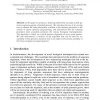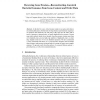WAW
2004
Springer
14 years 5 months ago
2004
Springer
WAOA
2004
Springer
14 years 5 months ago
2004
Springer
In competitive analysis, we usually do not put any restrictions on the computational complexity of online algorithms, although efficient algorithms are preferred. Thus if such an...
WABI
2004
Springer
14 years 5 months ago
2004
Springer
Abstract. In this paper we propose a chaining method that can align a draft genomic sequence against a finished genome. We introduce the use of an overlap tree to enhance the state...
WABI
2004
Springer
2004
Springer
Reversing Gene Erosion - Reconstructing Ancestral Bacterial Genomes from Gene-Content and Order Data
14 years 5 months ago
In the last few years, it has become routine to use gene-order data to reconstruct phylogenies, both in terms of edge distances (parsimonious sequences of operations that transform...
WABI
2004
Springer
14 years 5 months ago
2004
Springer
Abstract. Genomic instabilities, amplifications, deletions and translocations are often observed in tumor cells. In the process of cancer pathogenesis cells acquire multiple genom...
WABI
2004
Springer
14 years 5 months ago
2004
Springer
Abstract. We give an algorithm that locally improves the fit between two proteins modeled as space-filling diagrams. The algorithm defines the fit in purely geometric terms and...
WABI
2004
Springer
14 years 5 months ago
2004
Springer
—In practice, one is often faced with incomplete phylogenetic data, such as a collection of partial trees or partial splits. This paper poses the problem of inferring a phylogene...
WABI
2004
Springer
14 years 5 months ago
2004
Springer
—The problem of reconstructing the duplication history of a set of tandemly repeated sequences was first introduced by Fitch [4]. Many recent studies deal with this problem, show...
WABI
2004
Springer
14 years 5 months ago
2004
Springer
Abstract. Haplotype inference problem asks for a set of haplotypes explaining a given set of genotypes. Popular software tools for haplotype inference (e.g., PHASE, HAPLOTYPER) as ...
WABI
2004
Springer
14 years 5 months ago
2004
Springer



